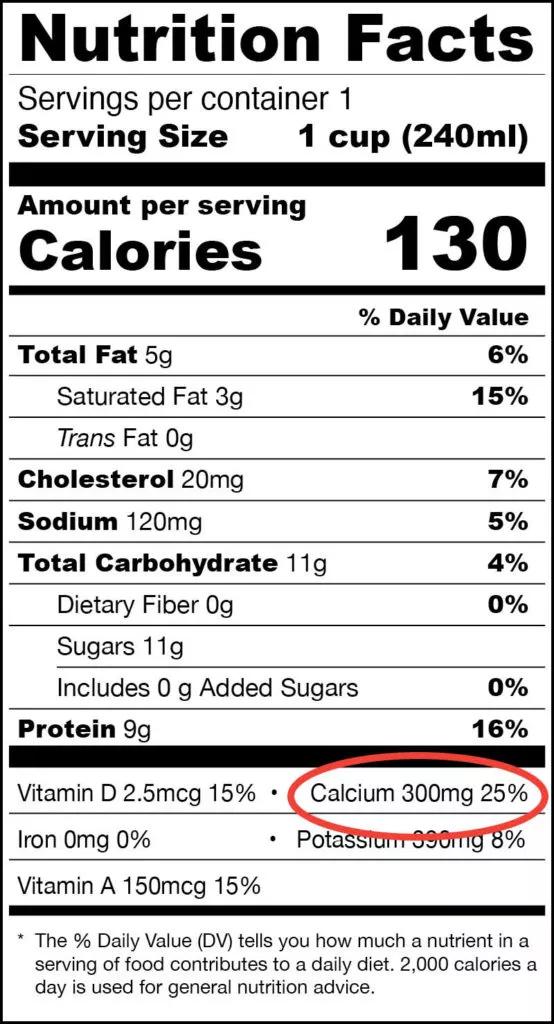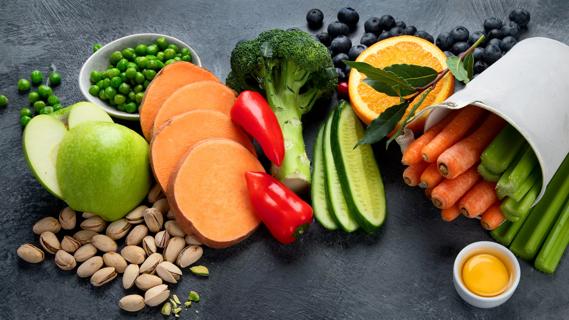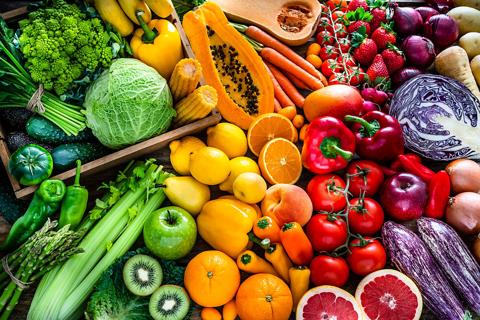
You know the saying, “There’s no use crying over spilled milk.” But missing out on the vital calcium milk provides may be a reason for a few tears.
Cleveland Clinic is a non-profit academic medical center. Advertising on our site helps support our mission. We do not endorse non-Cleveland Clinic products or services. Policy
Calcium is an essential mineral that keeps your bones and teeth strong. It’s also necessary for many of your body’s functions, such as muscle movement, blood clotting and nerve signaling.
Your body can’t make calcium — it must come from your diet. And according to registered dietitian Anthony DiMarino, RD, many Americans aren’t getting enough calcium.
“There’s a movement away from dairy products due to a rise in lactose intolerance and plant-based diet patterns,” DiMarino says. “People who don’t eat dairy or have higher calcium requirements should be more vigilant about getting enough calcium every day.”
The amount of calcium you need varies by your age and sex. In general, children, women who are post-menopause and adults over age 70 need more calcium. “As you grow older, your body absorbs less of the calcium in your diet,” explains DiMarino. “For women, hormonal changes during menopause can sap calcium from your bones.”
According to the U.S. Department of Agriculture, the recommended dietary allowances (RDAs) for calcium in milligrams (mg) are:
| Age | Recommended Amount |
|---|---|
| 0-6 months | 200 mg |
| 7-12 months | 260 mg |
| 1-3 years | 700 mg |
| 4-8 years | 1,000 mg |
| 9-13 years | 1,300 mg |
| 14-18 years | 1,300 mg |
| 19-50 years | 1,000 mg |
| 51-70 years (men) | 1,000 mg |
| 51-70 years (women) | 1,200 mg |
| 71+ years | 1,200 mg |
| Age | |
| 0-6 months | |
| Recommended Amount | |
| 200 mg | |
| 7-12 months | |
| Recommended Amount | |
| 260 mg | |
| 1-3 years | |
| Recommended Amount | |
| 700 mg | |
| 4-8 years | |
| Recommended Amount | |
| 1,000 mg | |
| 9-13 years | |
| Recommended Amount | |
| 1,300 mg | |
| 14-18 years | |
| Recommended Amount | |
| 1,300 mg | |
| 19-50 years | |
| Recommended Amount | |
| 1,000 mg | |
| 51-70 years (men) | |
| Recommended Amount | |
| 1,000 mg | |
| 51-70 years (women) | |
| Recommended Amount | |
| 1,200 mg | |
| 71+ years | |
| Recommended Amount | |
| 1,200 mg |
Most of the calcium in your body is stored in your bones and teeth. There’s a smaller amount in your blood and tissues.
Your body works hard to maintain a steady level of calcium in your blood. If your blood level falls because you’re not getting enough calcium in your diet, your bones will release calcium to bring the level up.
Over time, this process can weaken your bones and lead to:
Many foods can help increase calcium in your diet, even if you have lactose intolerance or eat a vegan diet. Try eating a variety of these foods to meet your daily calcium requirements:
Milk and dairy products are among the best calcium sources. Just a few servings per day can give you all the calcium you need. When choosing dairy products, don’t forget to look at the calories, fat and sodium, which can be high in some dairy foods.
| Food | Serving Size | Calcium |
|---|---|---|
| Vanilla yogurt (low-fat) | 8 ounces | 388 mg |
| Milk, 1% | 1 cup | 310 mg |
| Ricotta cheese, whole milk | 1/2 cup | 289 mg |
| Greek yogurt, plain (low-fat) | 8 ounces | 261 mg |
| Cottage cheese, 2% fat | 1 cup | 227 mg |
| Cheddar cheese | 1 ounce | 200 mg |
| Food | ||
| Vanilla yogurt (low-fat) | ||
| Serving Size | ||
| 8 ounces | ||
| Calcium | ||
| 388 mg | ||
| Milk, 1% | ||
| Serving Size | ||
| 1 cup | ||
| Calcium | ||
| 310 mg | ||
| Ricotta cheese, whole milk | ||
| Serving Size | ||
| 1/2 cup | ||
| Calcium | ||
| 289 mg | ||
| Greek yogurt, plain (low-fat) | ||
| Serving Size | ||
| 8 ounces | ||
| Calcium | ||
| 261 mg | ||
| Cottage cheese, 2% fat | ||
| Serving Size | ||
| 1 cup | ||
| Calcium | ||
| 227 mg | ||
| Cheddar cheese | ||
| Serving Size | ||
| 1 ounce | ||
| Calcium | ||
| 200 mg |
Leafy greens and broccoli are excellent sources of calcium. Generally, fruits aren’t calcium-rich, but some juices are fortified. This means the manufacturer has added calcium to the product. Fortified orange juice has more calcium than a glass of milk.
| Food | Serving Size | Calcium |
|---|---|---|
| Orange juice, calcium-fortified | 1 cup | 349 mg |
| Collard greens, cooked | 1 cup | 268 mg |
| Spinach, cooked | 1 cup | 245 mg |
| Bok choy, cooked | 1 cup | 158 mg |
| Kale, cooked | 1 cup | 177 mg |
| Broccoli, cooked | 1 cup | 62 mg |
| Food | ||
| Orange juice, calcium-fortified | ||
| Serving Size | ||
| 1 cup | ||
| Calcium | ||
| 349 mg | ||
| Collard greens, cooked | ||
| Serving Size | ||
| 1 cup | ||
| Calcium | ||
| 268 mg | ||
| Spinach, cooked | ||
| Serving Size | ||
| 1 cup | ||
| Calcium | ||
| 245 mg | ||
| Bok choy, cooked | ||
| Serving Size | ||
| 1 cup | ||
| Calcium | ||
| 158 mg | ||
| Kale, cooked | ||
| Serving Size | ||
| 1 cup | ||
| Calcium | ||
| 177 mg | ||
| Broccoli, cooked | ||
| Serving Size | ||
| 1 cup | ||
| Calcium | ||
| 62 mg |
Some proteins, such as tofu with added calcium sulfate, and canned fish with bones, are high in calcium. You may need to read the labels closely to decipher which foods can deliver your daily calcium dose.
| Food | Serving Size | Calcium |
|---|---|---|
| Tofu, prepared with calcium sulfate | 1/2 cup | 434 mg |
| Sardines, canned, with bones | 3 ounces | 324 mg |
| Soy milk, fortified | 1 cup | 299 mg |
| Black beans, canned | 1 cup | 239 mg |
| Salmon, canned, with bones | 3 ounces | 181 mg |
| Food | ||
| Tofu, prepared with calcium sulfate | ||
| Serving Size | ||
| 1/2 cup | ||
| Calcium | ||
| 434 mg | ||
| Sardines, canned, with bones | ||
| Serving Size | ||
| 3 ounces | ||
| Calcium | ||
| 324 mg | ||
| Soy milk, fortified | ||
| Serving Size | ||
| 1 cup | ||
| Calcium | ||
| 299 mg | ||
| Black beans, canned | ||
| Serving Size | ||
| 1 cup | ||
| Calcium | ||
| 239 mg | ||
| Salmon, canned, with bones | ||
| Serving Size | ||
| 3 ounces | ||
| Calcium | ||
| 181 mg |
Grains aren’t usually rich in calcium but are an important part of a balanced diet. Some breads and cereals are fortified and can be a great option for boosting your calcium intake. Check packaging and labels to find fortified options that you might enjoy.
Some nuts and seeds contain a robust amount of calcium. Try incorporating chia or sesame seeds into a smoothie, salad or your morning cereal.
| Food | Serving Size | Calcium |
|---|---|---|
| Almond milk, unsweetened | 1 cup | 482 mg |
| Almonds | 1/4 cup | 92 mg |
| Sesame seeds | 1 tablespoon | 88 mg |
| Chia seeds | 1 tablespoon | 78 mg |
| Tahini (sesame butter or paste) | 1 tablespoon | 64 mg |
| Food | ||
| Almond milk, unsweetened | ||
| Serving Size | ||
| 1 cup | ||
| Calcium | ||
| 482 mg | ||
| Almonds | ||
| Serving Size | ||
| 1/4 cup | ||
| Calcium | ||
| 92 mg | ||
| Sesame seeds | ||
| Serving Size | ||
| 1 tablespoon | ||
| Calcium | ||
| 88 mg | ||
| Chia seeds | ||
| Serving Size | ||
| 1 tablespoon | ||
| Calcium | ||
| 78 mg | ||
| Tahini (sesame butter or paste) | ||
| Serving Size | ||
| 1 tablespoon | ||
| Calcium | ||
| 64 mg |
Reading food labels is an important skill if you’re tracking your calcium intake.
Most food labels tell you exactly how many milligrams of calcium are in a serving. But some will only list the amount of calcium as a percentage of the daily value. In this case, you’ll have to do a calculation.
The percent of the daily recommended value is based on 1,200 milligrams of calcium. If the exact milligrams of calcium aren’t listed, you’ll need to determine the amount based on the percentage. For example, if one cup of milk is listed as 25% of the daily recommended value, then 25% of 1,200 is 300, so it has 300 milligrams of calcium.
And don’t forget to check the serving size. If you consume more or less than a serving, the amount of calcium will change accordingly. So, if one cup of milk has 300 milligrams of calcium, a half-cup contains 150 milligrams.

Lactose intolerance is the inability to digest lactose, a type of sugar found in cow’s milk. It occurs if you don’t have enough of the enzyme lactase, which helps you break down and digest lactose.
“People with lactose intolerance may still be able to eat dairy products with lower levels of milk sugar, such as hard cheeses and yogurt,” says DiMarino. “Everyone’s tolerance is a little different, so it might require some trial and error.”
Other calcium-rich options DiMarino recommends if you have lactose intolerance include:
To find out the nutritional content of your favorite foods, the U.S. Department of Agriculture has a handy tool you can use.
Supplements may be an option if you can’t get enough calcium in your diet. DiMarino recommends talking to your healthcare provider or dietitian before taking a supplement.
There are two main types of calcium supplements:
Read the labels carefully to find out the calcium levels and serving size. And remember that your body can only absorb about 500 milligrams at a time. If you need more than that, DiMarino recommends spacing out the doses during the day.
Since your bones weaken slowly over time, you might not know if you aren’t getting enough calcium. Many people don’t notice any symptoms until a bone fractures.
To prevent fractures related to osteoporosis, the U.S. Preventive Services Task Force recommends bone density screening for women age 65 and older. Healthcare providers may also screen postmenopausal women under 65 who are at risk of developing osteoporosis.
The best way to know if you’re getting enough calcium is to pay attention to your diet. By choosing calcium-rich foods, you can protect your bone health now and into the future.
Learn more about our editorial process.

A well-balanced diet with anti-inflammatory foods can help reduce flare-ups and severity of psoriasis symptoms

This vital nutrient helps your brain and body in many ways — and most of us need more of it

This powerful carotenoid can help with your eye and skin health, LDL reduction and cognitive function

Wrapped or sandwiched, try to choose fillings and condiments that are minimally processed, low in saturated fat and high in fiber

Beyond the usual offenders like garlic and onions, foods like red meat, fish and spices can cause a stink effect as well

Found in colorful foods like spinach, corn and oranges, this carotenoid helps with eye, skin and liver health

Found in an abundance of foods, potassium is an electrolyte that helps your muscles contract and acts as a counterbalance to sodium

There are several vitamins and mineral supplements that many people can benefit from — but it’s important to consult with a healthcare provider before you start one

Your metabolism may torch 1,300 to 2,000 calories daily with no activity

A gentle touch in all the right places may help drain your sinuses